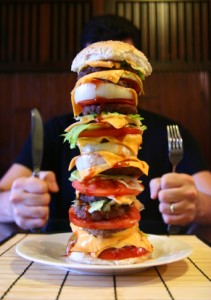Are Your Eating Habits Causing Diet Disaster?
Read time: 4-6 minutes
Following is a guest post by Joseph Coyne of Coyne Conditioning on the Gold Coast. Joseph is a fellow BioSignature coach, a Poliquin certified strength coach, and the Mens’ Fitness magazine Strength & Conditioning Expert – not to mention an excellent writer!

1) ‘The Mouth is Not a Vacuum’ Principle
Most people devour food as if they were a vacuum sucking up household dust and dirt. If you eat food while working, driving, browsing the internet and watching TV chances are you do this! It basically leads you to shovel in food without truly tasting or savouring it. To truly ram this home, mental health experts who specialize with the obese suggest that most overweight individuals don’t really like eating at all. They just consume without thinking deriving no pleasure from the food they eat. Experts call it ‘mindless eating’ and it is a big problem, especially if you are trying to drop the winter bulge. How do I fix this you ask?
Try the following:
- On a scale of 1-10, rate your feeling of hunger before eating. During eating, when you reach a 6 or a 7 on the hunger scale – STOP! Remember it takes 20 minutes for feelings of satiety to kick in so if you stop at a 6 chances are 5 minutes later you’ll be at a 9.
- Put down your fork between each bite and chew slowly, savouring the texture and taste of the food. Overeaters are actually taught to do this with a single raisin in clinics.
- Do not consume your main meals in front of a TV, computer, while driving or working. This will lead to a zombie like over-consumption.
- Avoid eating out of large sized containers. You will eat more without realizing it. Remember how pissed you were when you dined out at that flash restaurant and you got served this seemingly tiny portion on a massive plate. After moaning about value for money I bet you actually struggled to finish it. Is something clicking right about now?
By doing this, you will not only enjoy food more (even the healthy ones) but it will also help you recognize the difference between true hunger and a craving that is psychologically triggered like just being dumped.
2) The 20 Minute Principle
Basically, it takes around 20 minutes after you start eating for your hormones to kick in and say ‘Stop it NOW before we end up on The Biggest Loser!’. Insulin, cholecystokinin, leptin, cortisol and ghrelin are all stimulated by blood glucose and act as chemical cues from the stomach to the brain to indicate fullness. Try eating until you feel distinctly full and guaranteed you will be bursting your stomach’s seams in 20 minutes. This actually brings back memories of a plate full of chocolate éclairs that were violently ‘reproduced’ at my 10 year old birthday party. Not pretty.
Now this is how we manipulate this principle. Eat slower. Chew each mouthful at least 30 times. Use chopsticks or dessert forks for normal meals (although this could turn it into the 40 minute principle for some people). Do not get starved to begin with or you’ll eat too fast and bypass the 20 minute effect.
3) The Proximity Principle
Ok now for some more common sense from a great experiment that Chris Shugart has written about recently. 40 secretaries were studied on their snacking behaviour. The researchers either placed a bowl of chocolates on the secretaries’ desks or two metres away. Guess what? In between creeping on people with Facebook all day, they ate more when the chocolates were easily within reach. Basically if a food is in reach, hungry or not, you’ll eat it. You are less likely to eat something when it is further away from you.
Relating this to your everyday schedule is easy. Do not keep junk food in the house. I do not mind admitting that if I feel like something unwholesome and I have to leave the house and drive somewhere to get it, chances are I will not make that effort. Call me a lazy male but hey, it works for me. Also another big proximity problem is the cook will often constantly be eating as they prepare food. A great strategy if you find yourself about to blow your hardened diet resolve, is to just get out of the kitchen for 5 minutes. You’ll be surprised at how less hungry you are when you come back in.
4) The Visibility Principle
In the same secretaries study, the researchers also controlled the visibility of the chocolates by placing them in covered containers or clear uncovered bowls. Just like how the proximity of the food affected their eating patterns, the secretaries ate more chocolates when they were visible compared to covered. Plus the interesting thing with both the proximity & visibility variables is that they didn’t realise that they had eaten more.
Now I love dark chocolate and it is actually very good for you but the amount I was eating in hindsight wasn’t. Two Lindt 70% Cocoa chocolate blocks per day for an extended period of time is definitely a bit of overkill. After being quite disgusted with myself when I had figured out how much I had consistently binged on, I came up with an extravagant solution. I put them in my fridge below eye level and out of sight. It worked a ‘treat’ – no pun intended. Groundbreaking stuff eh?
Now the exact opposite works when you want to bulk up or put on mass. Most people I see who are trying to do this, eat barely enough to feed a small African child. So the idea here is to keep food as close and as visible as possible at all times. I’ll guarantee you’ll consume more and be closer to achieving your mass goals.
5) ‘The Always Room for Dessert’ Principle
After becoming full eating a certain type of food you will often become hungry again when a new food is offered or made available. This is called Sensory Specific Satiety and it is the classic dessert or buffet situation. I don’t think I need to explain further as I am sure we have all been there. Our desire for sweet and varied tastes is actually nature’s way of making sure we consume enough food variety and vitamins in our diet, especially Vitamin C. Humans actually cannot make Vitamin C and a theory behind our sweet tooth is that it prevents us contracting diseases like scurvy.
Recognise this principle and find ways to counter binging when new food is made available. By following the proximity and visibility principles guidelines, along with a few green grapes or even a tab of Vitamin C you can stop the “Always Room for Dessert’ principle ruining your eating plans.
These principles can make your fat loss plan a roaring success or an outstanding failure no matter how great the theory is behind the diet. Incorporating the above common sense methods into your life will not only boost you chances of shredding the fat and becoming much healthier, but it will also wrestle your psychological power and control back over food. It is a hard fight but a truly rewarding one. Best of luck to you all.
If you would like to learn more about the quickest individual fat loss methods and which type of diet is right for you, then consider a BioSignature assessment, or click here to visit Joseph’s site and check out more of his articles.
What’s your best tip for avoiding diet disaster? Or perhaps you’d be brave enough to share a tale of weakness to make the rest of us feel better!
A note from Kat
Until the end of October, whilst I’m living it up on my holiday, I’ll be introducing a series of posts from fellow Personal Trainers, BioSignature coaches, and wellness gurus. These are some of the most inspiring and useful people I know both on and offline, and I trust you’ll enjoy what they have to say. I’ll still be dropping by once a week with my own post and will be in touch via comments and email, so don’t be shy!
